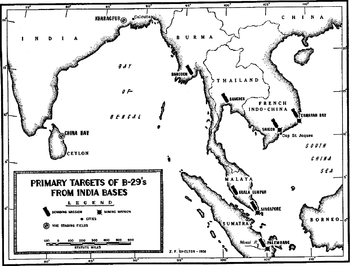Bombing of Kuala Lumpur (1945)
United States Army Air Forces B-29 Superfortress heavy bombers made two air raids on railway facilities in Japanese-occupied Kuala Lumpur during February and March 1945. The first of these attacks took place on 18 February, and involved 48 or 49 B-29s. The second raid was made on 10 March by either 24 or 26 aircraft. These attacks inflicted extensive damage on the Central Railroad Repair Shops. No American aircraft were lost in either operation.
Background

Japanese forces captured Kuala Lumpur on 11 January 1942 during the Malayan Campaign.[1] On 28 January that year, United States Army Air Forces (USAAF) Boeing B-17 Flying Fortress heavy bombers operating from Palembang in the Dutch East Indies bombed Japanese-held airfields near the city.[2] Kuala Lumpur later became a key railroad center for Japanese-occupied Malaya.[3]
In early 1944 the USAAF commenced the first deployment of its new B-29 Superfortress heavy bombers. As part of Operation Matterhorn, XX Bomber Command was based in India, and given the primary role of attacking targets in western Japan via airfields in central China. In addition, the Command was directed to also strike targets in Manchuria and East Asia.[4]
XX Bomber Command made its first deep penetration raid into South-East Asia on the night of 9/10 August 1944, when 56 B-29s made an unsuccessful attack against oil targets near Palembang during Operation Boomerang.[5] Attacks were also made against Singapore on 5 November and 11 January 1945.[6] On 15 January 1945, XX Bomber Command was directed to stop flying missions via China, and instead make "limited operations" against targets in Japanese-occupied areas of South East Asia from its bases in India. This was an interim use for the command, ahead of it being redeployed to the Marianas Islands in April where it would join the main strategic bombing effort against Japan.[7]
Attacks
The B-29s made a successful attack against Japanese naval facilities at Singapore on 1 February. Preparations commenced immediately afterwards for another raid against Singapore, which was scheduled for 6 February. However, on 3 February the South East Asia Command (SEAC) directed XX Bomber Command to not make further attacks on naval facilities in Singapore or Penang as it was hoped to capture them intact later in the war. SEAC's commander Louis, Lord Mountbatten specified that several targets in the Kuala Lumpur area would instead be XX Bomber Command's primary target. Industrial facilities in and around Singapore and Saigon were identified as the secondary targets.[8]
XX Bomber Command's first raid against Kuala Lumpur was made on 19 February. The target of this operation was the Central Railroad Repair Shops.[9] Either 48[10] or 49[9] B-29s from the 444th and 468th Bombardment Groups arrived over the city. The force descended to an altitude below 11,000 feet (3,400 m) to get below clouds. The attack was successful, with 67 percent of buildings at the workshop being destroyed, along with railway tracks and rolling stock.[9] Four other B-29s bombed alternate targets.[11] All of the B-29s returned to base.[10] As a result of this raid, many buildings in Kuala Lumpur did not display Japanese flags during a public holiday called to honour the Japanese forces in March due to fears that doing so would make them a target for any further Allied attacks.[12]
The 468th Bombardment Group made a second attack on the Central Railroad Repair Shops on 10 March. Either 24[13] or 26[9] B-29s made the attack. As no anti-aircraft guns fired on the bombers and few Japanese fighter aircraft were encountered, the B-29s descended to 8,700 feet (2,700 m). The bombing was highly accurate, and destroyed a roundhouse, several other buildings and other railroad equipment.[9] A museum was also severely damaged.[12] Three other B-29s attacked Khao Huakhang and one attempted to bomb a ship near Port Swettenham.[14] The American force did not suffer any losses.[13]
Aftermath
XX Bomber Command completed its last mission, an attack on Singapore, on 30 March. Its combat units subsequently moved to the Marianas Islands.[15]
Not all of the bombs dropped during the attacks on Kuala Lumpur exploded, and British Army Royal Engineers units needed to clear unexploded ordnance from the Kuala Lumpur railway yards following the war. A wartime bomb exploded outside Kuala Lumpur railway station in April 1949, leaving a 20-yard (18 m)-wide crater.[16]
References
Citations
- Ho, Stephanie. "Malayan Campaign". Singapore infopedia. National Library Board Singapore. Retrieved 21 August 2018.
- Carter & Mueller 1991, p. 10.
- "Kuala Lumpur Raid". The Sun. 11 March 1945. p. 3. Retrieved 21 August 2018 – via National Library of Australia.
- Correll 2009, pp. 62-63.
- Mann 2009, p. 40.
- Mann 2009, pp. 55, 84.
- Craven & Cate 1953, pp. 151-152.
- Craven & Cate 1953, pp. 160-161.
- Craven & Cate 1953, p. 162.
- Mann 2009, p. 103.
- Carter & Mueller 1991, p. 627.
- Kratoska 2018, p. 301.
- Mann 2009, p. 111.
- Carter & Mueller 1991, p. 642.
- Correll 2009, p. 65.
- Jackson 2013, p. 136.
Works consulted
- Carter, Kit C.; Mueller, Robert (1991). The Army Air Forces in World War II: Combat Chronology, 1941-1945. Washington, D.C.: Center for Air Force History. ISBN 0912799684.CS1 maint: ref=harv (link)
- Correll, John T. (March 2009). "The Matterhorn Missions" (PDF). Air Force Magazine. pp. 62–65. ISSN 0730-6784.CS1 maint: ref=harv (link)
- Craven, Wesley; Cate, James, eds. (1953). The Pacific: Matterhorn to Nagasaki. The Army Air Forces in World War II. Volume V. Chicago: The University of Chicago Press. OCLC 256469807.CS1 maint: ref=harv (link)
- Jackson, Ashley (2013). Buildings of Empire. Oxford: Oxford University Press. ISBN 9780191625176.CS1 maint: ref=harv (link)
- Kratoska, Paul H. (2018). The Japanese Occupation of Malaya and Singapore, 1941-45: A Social and Economic History (Second ed.). Singapore: NUS Press. ISBN 9789971696382.CS1 maint: ref=harv (link)
- Mann, Robert A. (2009). The B-29 Superfortress Chronology, 1934-1960. Jefferson, North Carolina: McFarland & Company. ISBN 9780786442744.CS1 maint: ref=harv (link)